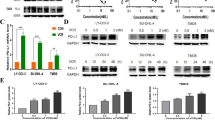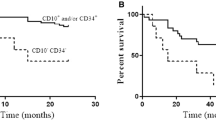Abstract
Multidrug resistance (MDR) lines from a murine T-cell lymphoid leukemia were selected in increasing vincristine (VCR) or doxorubicin (DOX) concentrations. Surface markers were determined by flow cytometry in both resistant (LBR-V160 and LBR-D160) and sensitive (LBR-) cell lines. Results obtained revealed similar expression of CD25, CD24, CD8, CD4, C18 and CD44, while differences in binding to hyaluronic acid (HA) were found. LBR- and LBR-D160 bound to HA only after phorbol ester (PMA) activation, while LBR-V160 failed to bind HA even after PMA treatment. Histopathological analysis disclosed that LBR-V160 was less invasive than LBR- and LBR-D160 cell lines. In vitro growth of cell lines analyzed by sulforhodamine-B uptake showed that doubling time for the three lines was 10.24 h (LBR-), 16.75 h (LBR-V160) and 16.29 h (LBR-D160). Mortality rate was determined after i.p. injection of 104 cells. Mice inoculated with LBR- died at 23 (± 2.11) days, while those inoculated with LBR-V160 or LBR-D160 died at 41 (± 9.53) or 41 (± 4.96) days, respectively. Our results demonstrated that leukemic murine T cells cultured in the long-term presence of VCR or DOX not only presented changes in the resistance phenotype but also variations in their growth and metastatic pattern.
Similar content being viewed by others
References
Takeda Y, Nishio K, Niitani H et al. Reversal of multidrug resistance by tyrosin-kinase inhibitors in a non-P-glycoprotein-mediated multidrug-resistant cell line.Int J Cancer1994;57:229–39.
Germann UA, Pastan I, Gottesman MM. P-glycoproteins: Mediators of multidrug resistance.Semin Cell Biol1993;4:63–70.
Berner HS, Davidson B, Berner A et al. Expression of CD44 in effusions of patients diagnosed with serous ovarian carcinoma-diagnostic and prognostic implications.Clin Exp Metastasis2000;18(2):197–202.
Gunthert U. CD44 in malignant disorders. In Gunthert U and Birchmeir W (eds): Current Topics in Microbiology and Immunology, 213/I. Attempts to Understand Metastasis Formation. Berlin/Heidelberg: Springer-Verlag1996;271–85.
Naor D, Sionov R, Ish-Shalom D. CD44: Structure, function and association with the malignant process.Adv Cancer Res1997;71: 241–319.
Screaton GR, Bell MV, Jackson DG et al. Genomic structure of DNA encoding the lymphocyte homing receptor CD44 reveals at least 12 alternatively spliced exons.Proc Natl Acad Sci USA1992;89: 12160–4.
Guriec N, Marcellin L, Gairard B et al. CD44 exon 6 expression as a possible early prognostic factor in primary node negative breast carcinoma.Clin Exp Metastasis1996;14(5):434–9.
Kogerman P, Sy MS, Culp LA. Over-expression of human CD44s in murine 3T3 cells: Selection against during primary tumorigenesis and selection for during micrometastasis.Clin Exp Metastasis1998; 16(1):83–93.
Stauder R, Gunther U. CD44 isoforms impact on lymphocyte activation and differentiation.The Immunologist1995;3:78–83.
Toyama-Sorimachi N, Sorimachi H, Tobita Y et al.A novel ligand for CD44 is serglycin, a hematopoietic cell lineage-specific proteoglycan. J Biol Chem1995;270:7437–44.
Weber GF, Ashkar S, Glimcher MJ et al. Receptor-ligand interaction between CD44 and osteopontin (Eta-1).Science1996;271:509–12.
Sleeman JP, Kondo K, Moll J et al. Variant exons v6 and v7 together expand the repertoire of glycosaminoglycans bound by CD44.J Biol Chem1997; 272:31837–44.
Borland G, Ross JA, Guy K.Forms and functions of CD44.Immunology 1998;93:139–48.
Catterall JB, Jones LM, Turner GA. Membrane protein glycosylaion and CD44 content in the adhesion of human ovarian cancer cells to hyaluronan. Clin Exp Metastasis1999;17(7):583–91.
Lopes EC, Scolnik M, Alvarez E et al. Modulator activity of PSC 833 and cyclosporin-A in vincristine and doxorubicin-selected multidrug resistant murine leukemic cells.Leukemia Res 2001(a); 25:85–93.
Sionov RV, Naor D. Hyaluronan-independent lodgment of CD44+ lymphoma cells in lymphooid organs.Int J Cancer 1997;71:462–9.
Cupis A, Pirani P, Fazzuoli L et al. Responsiveness to hormone, growth factor and drug treatment of a human breast cancer cell line: Comparison between early and late cultures.In Vitro Cell Dev Biol-Animal1998;34:836–43.
Slapak CA, Daniel JC, Levy SB. Sequential emergence of distinct resistance phenotypes in murine erythroleukemia cells under adriamycin selection: Decreased anthracycline uptake precedes increased P-glycoprotein expression.Cancer Res1990;50:7895–901.
Lopes EC, García M, Vellón L et al. Correlation between decreased apoptosis and multidrug resistance (MDR) in murine leukemic T cell lines.Leuk Lymph2001(b); 42:775–87.
Rochman M, Moll J, Herlich P et al. CD44 receptor of lymphoma cells: Structure–function relationship and mechanism of activation. Cell Adhes Comm2000;7:331–47.
Sielgeman MH, DeGrendele HC, Estess P. Activation and interaction of CD44 and hyaluronan in immunological systems.J Leukocyte Biol 1999;66:315–21.
Sanchez Lockhart M, Cabrera P, Diament M et al. Expression of CD44 splice variants in spontaneous murine tumors.Int J Mol Med2001;7: 557–62.
Lesley J, Hyman R, Kincade PW. CD44 and its interaction with extracellular matrix.Adv Immunol1993;54:271–335.
Lesley J, Hyman R. CD44 structure and fuction.Front Biosci1998; 3:616–30.
Johnson P, Maiti AM, Brown KL et al. A role for the cell adhesion molecule CD44 and sulfation in leukocyte–endothelial cell adhesion during an inflammatory response?Biochem Pharmacol2000;59: 455–65.
Stamenkovic I, Aruffo A, Amiot M et al. The hematopoietic and epithelial forms of CD44 are distinct polypeptides with different adhesion potentials for hyaluronan bearing cells.EMBO J1991;10: 343–8.
Fabris V, Ernst G, Lopes EC et al. Chromosomes studies of murine T-cell lymphoid leukemia and derived cell lines.Cancer Gen Cytogen 2001;130:62–7.
Author information
Authors and Affiliations
Corresponding author
Rights and permissions
About this article
Cite this article
Lopes, E.C., Ernst, G., Aulicino, P. et al. Dissimilar invasive and metastatic behavior of vincristine and doxorubicin-resistant cell lines derived from a murine T cell lymphoid leukemia. Clin Exp Metastasis 19, 283–290 (2002). https://doi.org/10.1023/A:1015548706673
Issue Date:
DOI: https://doi.org/10.1023/A:1015548706673




